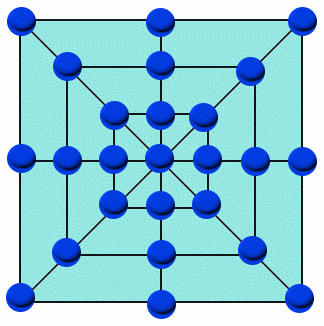Or search by topic
Number and algebra
Geometry and measure
Probability and statistics
Working mathematically
Advanced mathematics
For younger learners
Published 2000 Revised 2021
Learning Mathematics Through Games Series: 4. from Strategy Games
The first three articles in this series can be found here (Why Games?), here (Types of Games) and here (Creating Your Own Games).
There are several educationally useful ways of incorporating games into mathematics lessons. Games can be used as lesson or topic starters that introduce a concept that will then be dealt with in other types of activities. Some games can be used to explore mathematical ideas or develop mathematical skills and processes and therefore be a main component of a lesson. Perhaps the most common use of
games is for practice and consolidation of concepts and skills that have already been taught. Yet another way to use games is to make them the basis for mathematical investigations.
Basic Strategy Games
Basic strategy games are particularly suitable as starting points for investigations because players instinctively to try to discover a winning strategy, and usually the best way to do this is to analyse the outcomes of series of 'moves'. With a little encouragement from the teacher, a mathematical investigation is born. A few questions at the appropriate time will open up the task for the
children and lead to some good quality mathematical thinking.
For example, a basic version of the ancient game of NIM can be used to start an investigation.

Problem-Solving Skills
Analysing a game in this way will typically engage the student in some highly desirable problem solving strategies and processes: -
- being systematic,
- transforming information, (e.g. inventing a method for recording moves),
- searching for patterns,
- applying mathematics (calculations, algebra),
- manipulating variables,
- working backwards, simplifying the problem,
- hypothesising and testing, and
- generalising (perhaps even producing a formula)
What if you can take a different number of counters away?
Variations of the Same Game
A way to take the investigation further and hence the mathematics further is to introduce a variation of the game and search for winning strategies.



To analyse the game, it is helpful to start by playing it with only one counter, then two, then three. Clear strategies can be found with one counter, but the introduction of other counters allows blocking, which complicates the moves.
How can what has been discovered about these games be used t o create new challenging games?
The NIM game can also be extended into a two-dimensional game board.

Though complete analysis is too difficult, continuous scoring will help focus attention on early moves. (1 point for each counter removed, minus 5 for the last counter). Encourage the children to think backwards form the final move to discover helpful strategies towards the end of the game.
More Games?
All the games published monthly on the NRICH site are accompanied by questions that prompt mathematical thinking and investigations. Visit the games archive to find them.
An excellent source for groups of related strategy games is a book called "Strategy Games" by R. Sheppard and J. Wlikinson. It is published by Tarquin and available through their website.

